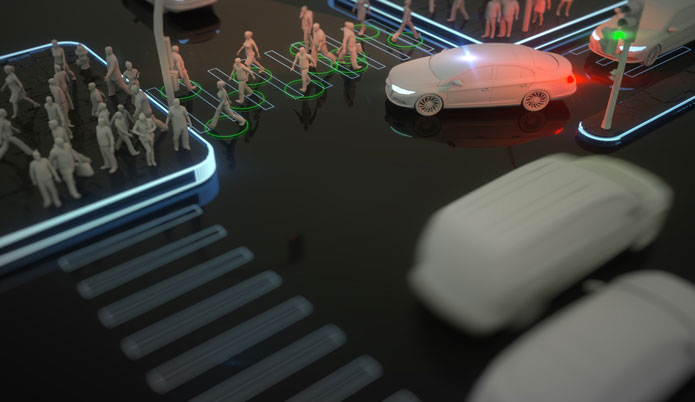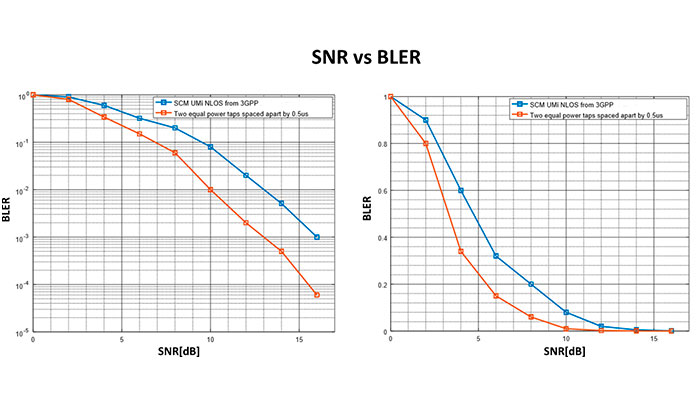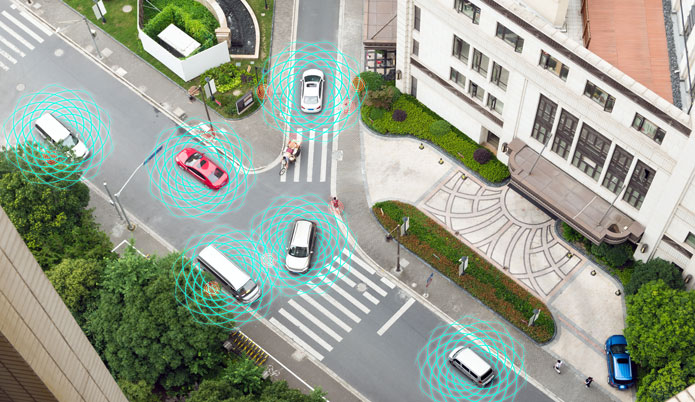Standardization of connectivity technologies for autonomous vehicles: C-V2X, U-V2X and 5G (Part 1)
Advances in key communications technologies have led to big improvements and expectations into the automotive market, particularly in the fields of automation and autonomous vehicles.
Industry working groups like SAE International and 3GPP have defined a six-level classification system to identify the different stages of automation towards fully autonomous driving. Vehicle connectivity, together with GNSS (satellite navigation) and ADAS (Advanced driver-assistance systems) functions are one of the key technology pillars for Full Autonomous Driving (Level 5). Currently, the achieved level is floating between level 1 for state-of-art mass production and level 3 in some pilots / demonstrators.
The chart below depicts the different automation levels, from level 0: No Automation to level 5: Full Automation).

Connectivity in a vehicle relies on the radio capabilities of its components, and its ability to connect intelligently with the world (vehicle-to-everything, or V2X). V2X requires the cooperation of different applications, including:
- Vehicle-to-vehicle (V2V), to avoid collisions by send position and speed data to one another
- Vehicle-to-infrastructure (V2I) to manage priority and timing of traffic signals
- Vehicle-to-network (V2N) to access to services like routing and real time traffic
- Vehicle-to-pedestrians (V2P) for detection, alerts notification and crash avoidance

All these applications are now in development and they are expected to be ready for large-scale commercial deployment from 2020+.
Automotive Tier-1 suppliers are now committed to the development and pilot trials of new Electronic Control Units (ECUs), capable of providing the proper functions to OEMs’ new vehicles, to achieve true driverless vehicles with wireless connectivity. At the same time, the challenges related to the validation and verification of such components and functionalities are increasing, for two main reasons:
- The standardization for conformance is still in progress and subject to several iterations until harmonization can be reached
- The technology itself is continuously evolving, causing changes in electronic ICs’ hardware and firmware. New ICs lead to new types of supported features solution implementation.
Connectivity technologies toward autonomous vehicles: C-V2X vs U-V2X
Autonomous vehicles require new communication technologies with broader capabilities in key RF parameters:
- Low latency [i], to enable the exchange of raw or processed gathered data and intention/trajectory sharing.
- High throughput [ii] is also needed in order to build local and dynamic high definition maps based on camera and sensor data, to be distributed at street intersections.
- Wideband capability: broadband carrier support is needed to achieve accurate positioning and ranging for cooperative and automated applications.
At the moment, there are two new technologies in the market for V2X communications, Cellular V2X and Unlicensed V2X. Both technologies offer sufficient levels of throughput and wideband to enable up to level 3 and 4 of autonomy.
Cellular V2X (C-V2X) is a unified technology platform that combines network-less, direct communications using the LTE protocol and unlicensed spectrum 5.9GHz (LTE-V2X PC5) for short range communications, with cellular network communications (LTE-V2X Uu) for long range communications. C-V2X can use either option; the PC5 interface is faster while the Uu interface provides more reliable performance because licensed spectrum has a dedicated band without interference.
The main drawback is that licenses are granted at national or regional level, and thus automotive OEMs must reach agreements with all the operators and licenced owners to provide a worldwide service. This issue causes delays in time-to-market in a technological environment which experiences rapid technical advances.
Unlicensed V2X (U-V2X) also plays an important role because no governmental license is required. U-V2X solutions have a shorter time-to-market and many of them are already in the trial phase. There are several U-V2X communication standards although some of them have settled at regional level.
In Europe IEEE 802.11p is the most used Standard for U-V2X Communications in the automotive industry. Coming from the same family as WLAN technology, IEEE 802.11p is dedicated to information exchange between vehicles and road infrastructure and operates at 5.9 GHz. From a technical point of view, its main drawback is the unpredictable electromagnetic interferences it might be subject to, which might affect the communication system. Interference can be minimized with technical solutions but vehicle ubiquity makes it hard to prevent all possible scenarios.
Toward a hybrid model
Although different technologies are available for use (Cellular and Unlicensed), studies [1][2] show that co-existence of both technologies 802.11p and C-V2X at 5.9 GHz and subject to market demand would deliver the highest societal benefits compared to scenarios where only one technology is mandated. Co-existence of 802.11p and C-V2X at 5.9GHz hybrid is possible and will be studied by European Committee CEPT/ETSI in response to the recent EC RSCOM mandate.
In the European Union, road safety regulations for intelligent transport systems are, on principle, technology-agnostic to avoid favouring one communication technology over another. Furthermore, the regulations guarantee that future technologies must be compatible with current systems in order to guarantee that technical advances never jeopardise safety.
However, a hybrid model implies interoperability challenges, as self-driving vehicles will need to be ready to switch between different network operators or technological profiles depending on environmental factors (tunnels, low-coverage conditions) and moving between different regions and countries. Interoperability is one of the issues now being addressed by means of standardisation and homogenisation of technical requirements.

Pilot tests and Use Cases: the importance of multipath and fading models
The ubiquity of vehicles must be considered when V2X solutions are put to the test. The propagation characteristics of electromagnetic fields used for communications are subject to environmental conditions, and vehicle surroundings are extremely variable (parks, tunnels, cities, broadcasting antennas, etc.).
Standardization bodies like 3GPP have defined a series of testing conditions to reproduce different environmental parameters that vehicles will encounter. These conditions focus on two key parameters:
- Multipath propagations: Electromagnetic fields propagate in every dimension of the space, reflecting when they reach encounter reflective surfaces (buildings, ground). The radio receptor will receive not only the original radio signal source but a signal continuously modified by the surroundings
- Signal Fading: Reflecting waves can be both constructive or destructives, thus modifying the original signal in different ways depending of the changing environment.
Although both phenomena have already been studied for mobile communications, mobile phones do not usually move at the same speed as cars, and even if they do, communication problems are not as critical to safety as they could be in an autonomous vehicle.
For these reasons, there is a need to further study the effect of both phenomena in automotive scenarios. Whichever spectrum access is used (cellular, unlicensed or hybrid), the communication system must be very robust in terms of multipath and fading.
As an active member of the main technical standardisation committees, including ETSI and 3GPP, Applus+ Laboratories decided to run several R&D test campaigns to verify some of the key technical issues in discussion. To do so, Applus+ took advantage of its strong background and expertise in EMC & Wireless testing for automotive.
We selected two Spatial Channel Models (SCM) defined by 3GPP to test the performance of V2X technologies in variable surrounding scenarios. During the test campaign, an unlicensed 802.11p device was tested in two different scenarios:
- SCM UMi NLOS from 3GPP: This model simulates an urban environment with multiple and changing obstacles, where there’s non-line of sight (NLOS) between the transmitter and receiver.
- Two equal power taps spaced apart by 0.5us: By contrast, this scenario simulates an open space, like a highway, with direct Line of Sight (LOS) between the transmitter and the receiver, with a single object in the middle causing interference.
The results in both graphs below showed that the radio device performed significantly differently in terms of fading and multipath in each scenario: a technical issue that could lead to catastrophic results on the road. The tests results also highlighted the importance of standardised validation tests for these technologies in specialised laboratories with a background in testing similar equipment and devices.

Future scenarios: 5G Expectations for Autonomous vehicles
As we have shown, C-V2X and U-V2X might be the present; however, neither of them are powerful enough to enable level 5 vehicle autonomy. This is the reason why the implementation of the new 5G network has raised such expectations. 5G will allow for better communications performance with high throughput sensor sharing, intention trajectory sharing and wideband ranging and position.
5G will deliver better performance enabling truly autonomous vehicles, but it also raises key challenges in both the engineering and the testing arenas.
From the engineering perspective, RF technologies prior to 5G were considered omni-directional. In contrast, with 5G, beam forming and the direction of radiation are two critical parameters.
From the test perspective, there are also important changes. While historically RF have been developed and tested separately from antennas, with the arrival of 5G there will be the need of testing antennas and RF devices working together as a system.
In terms of performance metrics, while historically Total Radiated Power (TRP) and Total Isotropic Sensitivity (TIS) were the typical KPIs. With 5G, new KPIs focused on Beam forming and Tracking or dynamic OTA environments will be required.

Worldwide allocation bands scenario for 5G
5G is currently being deployed worldwide, but its implementation is controlled at national level. In order to start the deployment of 5G, national authorities have started to license the new frequency bands that were added to the previously existing bands.
- Below 6GHz various 3.1-5GHz bands have been dedicated to 5G in the US, China, EU, Japan, Korea, etc.
- At millimetre waves (mmW) new bands have also been assigned to 5G, highlighting the 24-30GHz globally used as well as the 37-43GHz initially used in US and China.
5G a change of perspective
In the evolutionary path of cellular communication technologies, the development of applications have been limited to the available technologies. Conversely, 5G was designed in the opposite direction. Technical committees collected the requirements of new applications, like autonomous driving, and then developed a new communication technology. For the first time, a technology will not limit its applications since it was designed with the applications in mind.
To wrap up
Present day connectivity technologies, C-V2X and U-V2X, are already powering the first steps towards autonomous driving and self-driving cars, but both technologies have pros and cons. Studies show that a hybrid model might be beneficial for both industry and consumers, and also fits with regulatory bodies’ philosophy of technology-agnosticism. Future technologies must also be backwards compatible.
Autonomous vehicles will pass critical driving decisions from humans to machines, and these machines’ behaviour must be homogenous for all manufacturers of both vehicles and other devices that may interact with vehicles (V2X). This means a full standardization for the whole industry and for every country. Even if the technology is not yet at level 5, in this case standardization must be ready before the technology is developed. Global industry committees are already working on it.
5G throughput and wideband capabilities will be key to unlock the full potential of autonomous driving. However, 5G communication systems raise new challenges in product development and specifically in testing. Former testing methods are no longer valid to test fully automated components and vehicles. This article will be followed by the testing challenges of driverless vehicles where test methods and technological constraints will be analysed.
NOTE: The content of this article was presented by the authors to the IoT Catalan Alliance, in which Applus+ Laboratories is an active member.
1. For reference purposes we have listed some of the most relevant standards on the field:
[1] ECC Report 101, Compatibility Studies in the band 5855– 5925 MHz between Intelligent Transport Systems (ITS) and other systems
[2] ECC Recommendation (08)01, Use of the band 5855-5875 MHz for Intelligent Transport Systems (ITS)
[3] ETSI EN 302 571 v2.1.1 Intelligent Transport Systems (ITS); Radiocommunications equipment operating in the 5 855 MHz to 5 925 MHz frequency band;
[4] (DRAFT) DTS/ITS-0010015 v1.1.4 (TS 101 539-2 ) Intersection Collision Risk Warning Specification
[5] DECISION ITSWG1(18)042010 Add Level of automation to data element “VehicleRole”
[6] 3GPP TS 22.185 Service requirements for V2X services
[7] (DRAFT) 3GPP TR 37.885 Study on evaluation methodology of new Vehicle-to-Everything V2X use cases for LTE and NR
[8] 3GPP TS 24.386 User Equipment (UE) to V2X control function; protocol aspects; Stage 3
[9] 3GPP TS 38.522 V0.1.0 NR; User Equipment (UE) conformance specification; Applicability of RF and RRM test cases (Release 15)
[10] 3GPP TS 24.386 User Equipment (UE) to V2X control function; protocol aspects; Stage 3
[i] Latency in communication is the delay from input into a system to the desired outcome by processing and propagation effects. Very Low latency is required for real-time applications as autonomous driving.
[ii] The throughput is the measure of the amount of data which can be transmitted/received per unit of time. High Throughput is required for sharingall available information between users.